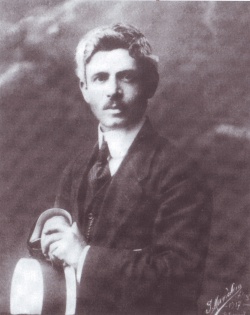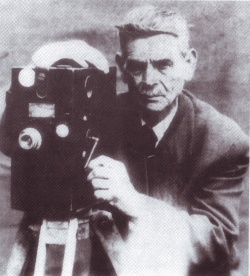Difference between revisions of "Yanaki and Milton Manaki"
Sorindanut (talk | contribs) (news) |
Sorindanut (talk | contribs) |
||
| Line 7: | Line 7: | ||
In honor of their work, the International Cinematographers' Film Festival "Manaki Brothers" is held every year in Bitola, the city where most of their activities were organized. In total, they took over 17,300 photographs in 120 localities. | In honor of their work, the International Cinematographers' Film Festival "Manaki Brothers" is held every year in Bitola, the city where most of their activities were organized. In total, they took over 17,300 photographs in 120 localities. | ||
| + | |||
| + | ; The first Etnographic film - ''The Weavers'' | ||
| + | * 1904. Rudolf Pöch (1870-1921), doctor, anthropologist, and ethnologist after an expedition to New Guinea (1901–1906), where he was the first to find scientific evidence for the existence of pygmies. His technical equipment (a photo camera, a cine camera and a phonograph) made possible to take pictures, video and audio documents of the indigenous population. | ||
| + | * 1905. The Weavers is a silent, black and white documentary film made in 1905 (?!) by the Manakis brothers in the small Aromanian village of Avdella, in the Ottoman vilayet of Monastir. It depicts the Manaki's aunts and 114-year-old grandmother Despina spinning and weaving. It is said to be the first film shot in the Ottoman Balkans. The film is shot with 35 mm film with an Urban Bioscope movie camera (serial number 300) imported from London. The mouvie is not a big archievent (just a family scene) but open the road to ethographic movie. | ||
; Awards | ; Awards | ||
Revision as of 07:52, 7 June 2013
The brothers Ianachia (Avdella, Ottoman Empire, 1878 – Thessaloniki, Greece, 1954) and Milton Manachia (Avdella, Ottoman Empire, 1882 – Bitola, SFR Yugoslavia, 1964) were pioneering photographers and the first filmmakers in the Balkans.
Ienache (Ion, Ianakis) - the big brother (18.05.1878-19.05.1954) and Milton (Miltiade) - the little brother (9.09.1882-5.03.1964) were born in North of Greece (Avdella), place who was till 1912 a part of the Ottoman Empire. They began to work together in 1898. Ienache open an photographic studio at Ianina (Epir), where he worked as a teacher of drawing and caligraphy. The brother had to leave Ianina in 1905 after the scandal of Vouvousa and they came back in Macedonia in Bitola (Monastir) where they open the famous Studio of Art and Photography - the label was written in both language: Romanian and Turk, the official language of the Ottoman Empire. The Manakis Brother they became the official photographers of the Romanian Court Royal in 1906, of the Ottoman in 1911 and of king Aleksandar Karadjordevic in 1929.
In honor of their work, the International Cinematographers' Film Festival "Manaki Brothers" is held every year in Bitola, the city where most of their activities were organized. In total, they took over 17,300 photographs in 120 localities.
- The first Etnographic film - The Weavers
- 1904. Rudolf Pöch (1870-1921), doctor, anthropologist, and ethnologist after an expedition to New Guinea (1901–1906), where he was the first to find scientific evidence for the existence of pygmies. His technical equipment (a photo camera, a cine camera and a phonograph) made possible to take pictures, video and audio documents of the indigenous population.
- 1905. The Weavers is a silent, black and white documentary film made in 1905 (?!) by the Manakis brothers in the small Aromanian village of Avdella, in the Ottoman vilayet of Monastir. It depicts the Manaki's aunts and 114-year-old grandmother Despina spinning and weaving. It is said to be the first film shot in the Ottoman Balkans. The film is shot with 35 mm film with an Urban Bioscope movie camera (serial number 300) imported from London. The mouvie is not a big archievent (just a family scene) but open the road to ethographic movie.
- Awards
- 1906, 2 gold medals and 1 silver medal at the International Exposition in Bucharest
- See also
- Literature
- Marian Ţuţui, Orient Express: filmul românesc şi filmul balcanic sau Cinematograful balcanic, Bucharest: Editura Noi Media Print, 2008. (in Romanian)
- External links

